The 2013 MacBook Air Review (13-inch)
by Anand Lal Shimpi on June 24, 2013 12:01 AM ESTCPU Performance
To measure CPU performance we begin with a fairly standard measure of system responsiveness: boot time. With the last generation of upgrades to 6Gbps SATA, we saw a good decrease in boot time over the previous generation platforms. The new 13-inch MBA's PCIe SSD takes the crown as it boots ever so slightly quicker than last year's setup. In practice the difference is subtle, but something you can appreciate as the 2013 MBA's IO is just snappier all over.
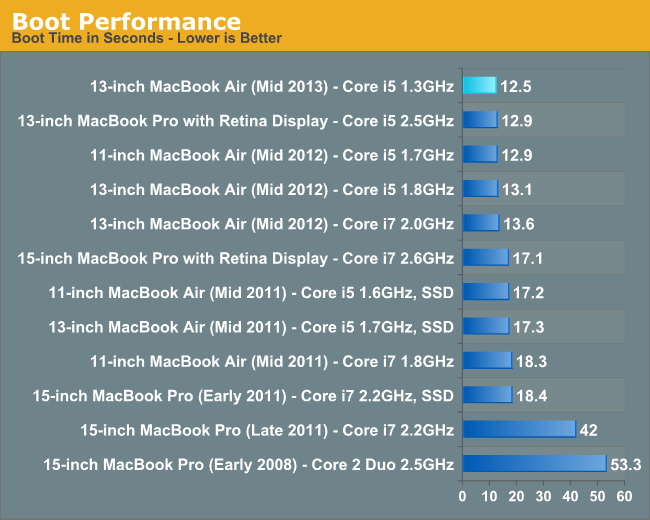
These next two charts look at single and multithreaded floating point performance using Cinebench 11.5. This test also gives us the rare opportunity of comparing to some older Mac Pro hardware as well from 2008 - 2010. Single threaded performance remains extremely important to overall system responsiveness, so it's always good to look at. As we found in our initial look at the new MBA, the 1.3GHz Core i5 CPU ends up performing about the same as last year's 1.8GHz part. I'd like to say it's all because of cooling and turbo boost, but in all likelihood Apple is trading some of Haswell's IPC gains for frequency here - enabling identical performance, at lower clocks thanks to Haswell's more efficient architecture.
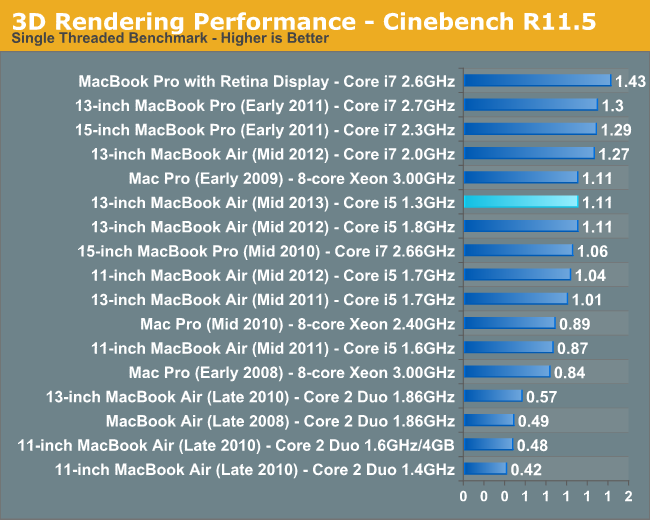
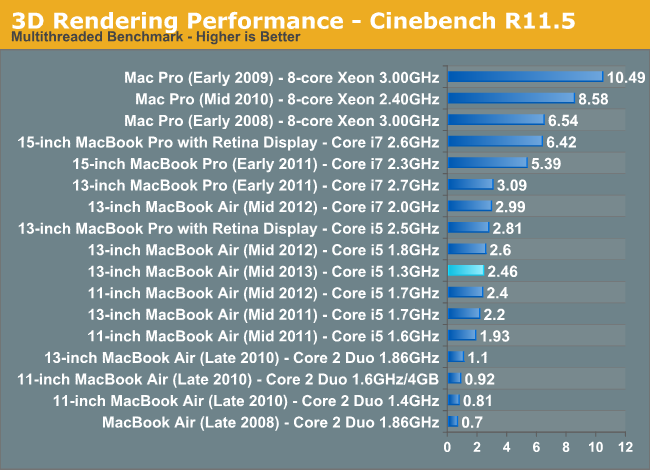
The multithreaded performance story is a bit different. The 1.3GHz i5 regresses in performance by about 5%. Overall performance is still quicker than the 2011 models, as well as the i7 based 11-inch MBA from 2012. Here we're simply seeing the 15W TDP limits come into play. Sharing both PCH and dual-core CPU power in a lower thermal footprint than last year's CPU alone is responsible for what we see above.
Video transcoding is really best suited for the higher end machines, but that doesn't change the fact that it's done on MacBook Airs as well. We'll start by looking at performance under iMovie. Here we're importing 1080p video from a Nikon D7000 and optimizing it during import.
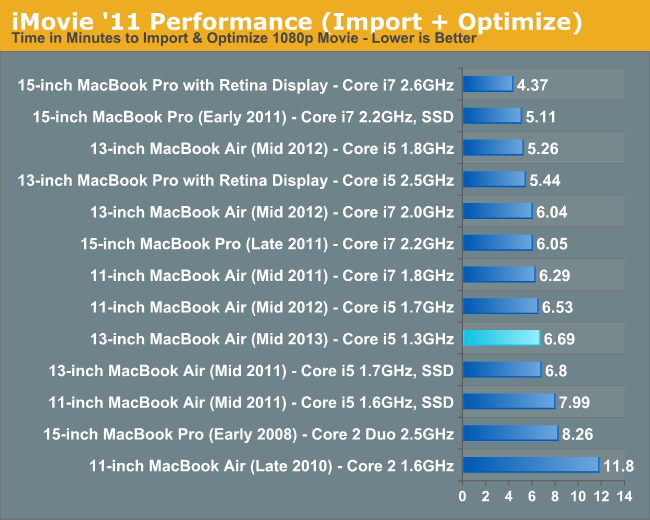
The 13-inch 1.3GHz Core i5 configuration performs similarly to last year's 11-inch 1.7GHz config. It's an interesting comparison because the 11-inch 2012 model is more thermally constrained than the 13-inch 2012 model, which is exactly what we see when we compare the 2013 13-inch MBA to the 2012 13-inch MBA. In this case the 2013 model is a hair quicker than the 2011.

We see a similar story for a full video export. The 1.3GHz 2013 MBA slots in behind the 2011 model in this CPU bound test.
Final Cut Pro X falls on the professional end of the video production spectrum. The test file is the same here, but the workload is far more strenuous.
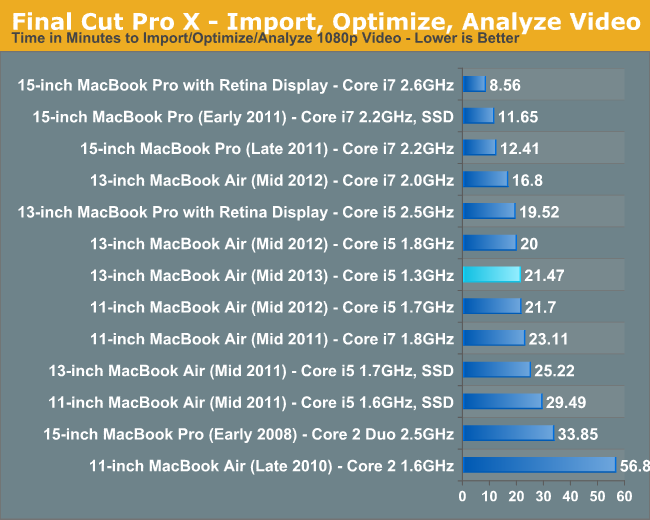
Once again, we see roughly the same performance from the 13-inch 2013 1.3GHz i5 as the 11-inch 2012 MBA. Here we do see substantially better performance than the 2011 models.
Our two photo workloads generally agree with what we saw in the video tests. The 1.3GHz Haswell part is definitely slower than th e previous generation 1.7/1.8GHz SKUs:
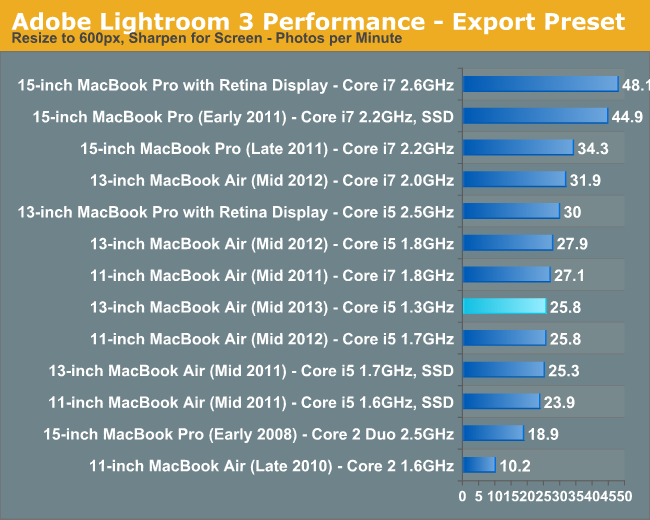
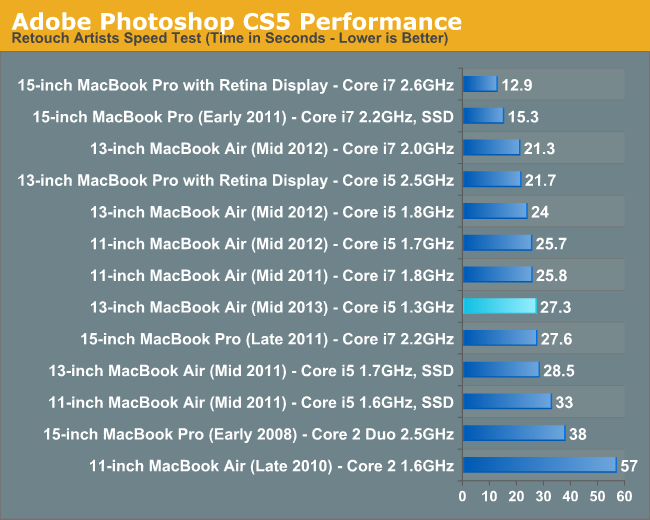
In our desktop review of Haswell I noted that performance in our compile test improved tremendously with the new architecture. As it's quite obvious that Haswell's IPC advantages don't surface all that much in our traditional suite, I wanted to see if perhaps things would be different in something that might lend itself better to Haswell's IPC improvements. I repeated our Firefox build test but under OS X. It's a multithreaded compile, with the number of threads set to 2x the number of cores (not threads) in a system. Unfortunately I came up with this bright idea while traveling, so I only had access to three machines: the 2013 13-inch MBA, the 15-inch rMBP and a 2GHz Core i7 2012 13-inch MBA. I'll add more results later, but I'm expecting this to be a part of our test suite going forward.

The combination of Haswell and a really fast SSD appears to help narrow the gap between the much higher clocked 2012 model and the base 2013 13-inch MBA. Here the faster Ivy Bridge CPU is less than 2% quicker. I'll reserve final judgements until I get my hands on the 1.7GHz Core i7 model, but my guess is this is an example of the best case scenario for Haswell where you get equivalent performance to a higher clocked Ivy Bridge part but with much better thermal/noise/battery life characteristics. For example, the fan was never audible on the 2013 MBA while running this test compared to running at a very noticeable volume on the 2012 Core i7 model. The same goes for temperatures. The i7 2012 model tends to run about 5% warmer along the bottom of the chassis compared to the 2013 i5.










233 Comments
View All Comments
spronkey - Monday, June 24, 2013 - link
Hmm. Very interested to see the CPU and battery life numbers for the i7 upgrade. If it manages to increase performance by 10% or so, and decrease battery life 10% or so, it could be a nice sweet spot.Bkord123 - Tuesday, June 25, 2013 - link
I can't wait for the i7 review. I think it's the once I'm leaning toward getting.timmyj9 - Monday, June 24, 2013 - link
i would be curious to know if the same 802.11ac file sharing bottlenecks occur when using NFS as the file sharing protocol?Kevin G - Monday, June 24, 2013 - link
It would as the tweak to resolve it was made to TCP and modern NFS are built on top of that.Khato - Monday, June 24, 2013 - link
Can't agree more that Haswell battery life is already blurring the lines with current tablets. I'm curious how the 2013 Tablet Bench Web Browsing suite compares specifically to the one used on notebooks? In the details provided in this review the specific frequency of web page loading is specified while it's not in the Tablet version.The iPad 4 with it's 42.5Wh battery and 9.48 hours of run-time in the test draws an average of 4.48W. If that test is comparable to the Light version shown here then you have the Haswell Macbook Air drawing an average of 4.9W, while if it's comparable to the Medium version then the average is 6.05W. Either way, when you consider that the Macbook Air's 13.3" diagonal screen has 1.88x more surface area than the iPad 4 (nit is another term for cd/m^2, so total luminous intensity of a 13.3" screen at 200 nits is 1.88x that of a 9.7" screen at 200 nits) it's pretty much a given that display power for the Macbook Air is higher than for the iPad 4 despite the lower resolution. Pretty cool.
Shivansps - Monday, June 24, 2013 - link
The HD5000 is running on single channel right? there is a 2do slot for another memory?Kevin G - Monday, June 24, 2013 - link
The entire SoC has dual channel memory. The MacBook Air has no memory expansion slots. If you want to get one of these, be sure to order with the amount of memory you think you'd need in the future.Shivansps - Monday, June 24, 2013 - link
Im saying that because of the IGP performance, i cant find any confirmation on the review that the MBA is running on dual channel memory, 4GB LPDDR3 sounds like 64 bit single channel to me, and that will impact IGP performance, even HD3000 has reduced 3D performance if not running on dual channel.Glindon - Monday, June 24, 2013 - link
Every Macbook Air that I've owned ran in dual channel mode. Why would this year's be any different.Kevin G - Monday, June 24, 2013 - link
Note the part in this article referring to the LPDDR3. It indicates that it has four 32 bit LPDDR3 packages which indicate a 128 bit wide bus (dual channel).